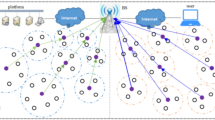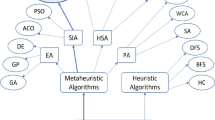Abstract
A Wireless Sensor Network (WSN) is an interdisciplinary discipline of sensing, electronics and wireless communication employed widely in environmental monitoring and surveillance applications. The sensor nodes are generally tiny and made of irreplaceable power source and limited capacity for computing, communication, and storage. The power constraint necessitates that the WSN routing protocols conserve energy as critical factor to maximize the network lifetime. Cluster-based approaches are popularly used for its energy efficiency where some nodes designated as Cluster Heads (CHs) organize WSNs for data aggregation and energy saving. The CH is responsible for gathering data from the cluster nodes and conveying it to the base station due to which higher energy drain occurs at CH leading to uneven network degradation. Thus, the selection of CH is critical for improving the WSN performance and lifetime. In this paper, a hybrid Shuffled Frog Leaping Algorithm (AASFLA) with antipredator capabilities to avoid the local minima is proposed. Results show avoidance of suboptimal solution compared to SFLA and particle swarm optimization.





Similar content being viewed by others
References
Luo, J., & Hubaux, J. P. (2010). Joint sink mobility and routing to maximize the lifetime of wireless sensor networks: The case of constrained mobility. IEEE/ACM Transactions on Networking (TON), 18(3), 871–884.
Suri, P., Bedi, R. K., & Gupta, S. K. (2015). Review paper on various clustering protocols used in Wireless Sensor Network (WSN). In Electrical, electronics, signals, communication and optimization (EESCO), 2015 international conference on (pp. 1–4). IEEE.
Hefeeda, M., & Bagheri, M. (2007). Wireless sensor networks for early detection of forest fires. In Mobile adhoc and sensor systems, 2007. MASS 2007. IEEE international conference on (pp. 1–6). IEEE.
Li, L., & Wen, X. M. (2008). Energy efficient optimization of clustering algorithm in wireless sensor network. Journal of Electronics and Information Technology, 30(4), 966–969.
Yu, J., Qi, Y., & Wang, G. (2011). An energy-driven unequal clustering protocol for heterogeneous wireless sensor networks. Journal of Control Theory and Applications, 9(1), 133–139.
Sert, S. A., Bagci, H., & Yazici, A. (2015). MOFCA: Multi-objective fuzzy clustering algorithm for wireless sensor networks. Applied Soft Computing, 30, 151–165.
Lou, C., Gao, X., Wu, F., & Chen, G. (2015). Energy-aware clustering and routing scheme in wireless sensor network. In Wireless algorithms, systems, and applications (pp. 386–395). Qufu: Springer International Publishing.
Kaur, N., & Sharma, J. P. (2015). Mobile sink and ant colony optimization based energy efficient routing algorithm. International Journal of Computer Applications, 121(1), 23–31.
Vijay, U., & Gupta, N. (2013). Clustering in WSN based on minimum spanning tree using divide and conquer approach. International Journal of Computer Science and Engineering, 7(7).
Ye, W., Heidemann, J., & Estrin, D. (2002). An energy-efficient MAC protocol for wireless sensor networks. In INFOCOM 2002. In Twenty-first annual joint conference of the IEEE computer and communications societies. proceedings. IEEE (Vol. 3, pp. 1567–1576). IEEE.
Li, B., & Zhang, X. (2012). Research and improvement of LEACH protocol for wireless sensor network. Lecture Notes in Information Technology, 25, 48.
Xunli, F. A. N., & Feiefi, D. U. (2015). Shuffled frog leaping algorithm based unequal clustering strategy for wireless sensor networks. Applied Mathematics, 9(3), 1415–1426.
Jain, N., & Trivedi, P. (2012). An adaptive sectoring and cluster head selection based multi-hop routing algorithm for WSN. In Engineering (NUiCONE), 2012 Nirma University international conference on (pp. 1–6). IEEE.
Li, Y. Z., Zhang, A. L., & Jin, S. (2012). WSN clustering algorithm based on cluster head reappointment. In Instrumentation, measurement, computer, communication and control (IMCCC), 2012 second international conference on (pp. 813–816). IEEE.
Abusaimeh, H., & Yang, S. H. (2012). Energy-aware optimization of the number of clusters and cluster-heads in wsn. In Innovations in information technology (IIT), 2012 international conference on (pp. 178–183). IEEE.
Mezghani, O., & Abdellaoui, M. (2014). Improving network lifetime with mobile LEACH protocol for Wireless Sensors Network. In Sciences and techniques of automatic control and computer engineering (STA), 2014 15th international conference on (pp. 613–619). IEEE.
Izadi, D., Abawajy, J., & Ghanavati, S. (2013). A new energy efficient cluster-head and backup selection scheme in WSN. In Information reuse and integration (IRI), 2013 IEEE 14th international conference on (pp. 408–415). IEEE.
Sathian, D., Baskaran, R., & Dhavachelvan, P. (2012, July). Lifetime enhancement by cluster head cooperative trustworthy energy efficient MIMO routing algorithm based on game theory for WSN. In computing communication and networking technologies (ICCCNT), 2012 third international conference on (pp. 1–5). IEEE.
Chen, K. (2013). Unequal cluster-based routing protocol in wireless sensor networks. Journal of Networks, 8(11), 2656–2662.
Binitha, S., & Sathya, S. S. (2012). A survey of bio inspired optimization algorithms. International Journal of Soft Computing and Engineering, 2(2), 137–151.
Mehta, S., & Banati, H. (2012). Trust aware social context filtering using Shuffled Frog Leaping Algorithm. In Hybrid Intelligent Systems (HIS), 2012 12th international conference on (pp. 342–347). IEEE.
Jaballah, S., Rouis, K., Ben Abdallah, F., & Tahar, J. B. H. (2014). An improved shuffled frog leaping algorithm with a fast search strategy for optimization problems. In Intelligent computer communication and processing (ICCP), 2014 IEEE international conference on (pp. 23–27). IEEE.
Qiusheng, W., Yong, C., Haiwen, Y., & Yingyi, L. (2012, December). The modified shuffled frog leapping algorithm and dynamic behavior analysis of local search process. In Instrumentation, measurement, computer, communication and control (IMCCC), 2012 second international conference on (pp. 219–223). IEEE.
Wang, L., & Gong, Y. (2013). A fast shuffled frog leaping algorithm. In Natural computation (ICNC), 2013 ninth international conference on (pp. 369–373). IEEE.
Eghbal, M., Saha, T. K., & Hasan, K. N. (2011). Transmission expansion planning by meta-heuristic techniques: A comparison of shuffled frog leaping algorithm, PSO and GA. In Power and energy society general meeting, 2011 IEEE (pp. 1–8). IEEE.
Roy, P., & Chakrabarti, A. (2011). Implementation of genetic algorithm and modified shuffled frog leaping algorithm for transmission loss minimum re-scheduling. In India conference (INDICON), 2011 Annual IEEE (pp. 1–4). IEEE.
Bellare, M., & Neven, G. (2006). Identity-based multi-signatures from RSA. In M. Abe (Ed.), Topics in cryptology–CT-RSA 2007 (pp. 145–162). Berlin: Springer.
Zhang, H., & Song, Y. (2014). Study on the survival of wireless sensor networks based on hierarchical topology control method. Journal of Networks, 9(9), 2482–2489.
Holland, J. H. (1973). Genetic algorithms and the optimal allocation of trials. SIAM Journal on Computing, 2(2), 88–105.
Author information
Authors and Affiliations
Corresponding author
Rights and permissions
About this article
Cite this article
Anandamurugan, S., Abirami, T. Antipredator Adaptation Shuffled Frog Leap Algorithm to Improve Network Life Time in Wireless Sensor Network. Wireless Pers Commun 94, 2031–2042 (2017). https://doi.org/10.1007/s11277-016-3354-1
Published:
Issue Date:
DOI: https://doi.org/10.1007/s11277-016-3354-1




